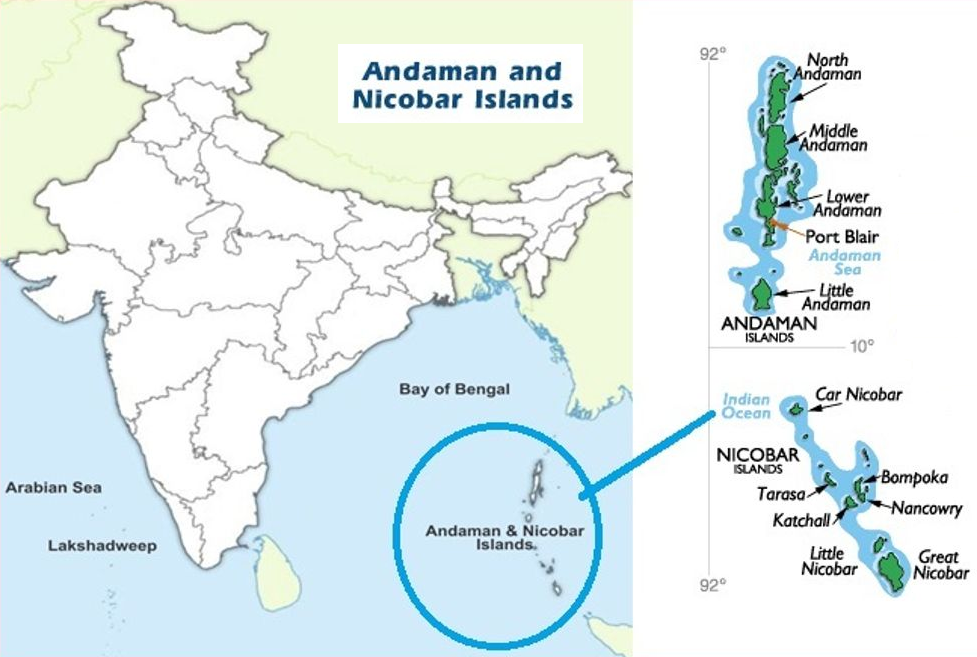Scattered across the Arabian Sea and the Bay of Bengal, the Indian Islands or the islands of India are the regions of strategic importance and rich biodiversity. Their multifarious significance makes them invaluable assets to India as well as the subcontinent. This article of NEXT IAS aims to study in detail the Indian Islands, including their categorization, major features, geomorphology, and significance.
About the Indian Islands
The Indian Islands refer to the group of islands, scattered across the Indian Ocean, the Arabian Sea, and the Bay of Bengal, which form parts of the territory of India. Together, they constitute one of the 5 physiographic divisions of India.
They are, broadly, categorized into two main groups of islands:
- The Andaman and Nicobar Islands
- The Lakshadweep Islands

The Andaman and Nicobar Group of Islands
- Location: They are a group of islands of India, located in the Bay of Bengal.
- Extent: These islands form an arcuate chain (convex to the west) and extend from 6° 45′ N to 13° 41′ N and from 92° 12′ E to 93° 57′ E.
- They stretch for a distance of about 590 km with a maximum width of about 58 km.
- Major Islands in the Group: This archipelago is composed of more than 500 big and small islands, which are divided into two distinct groups of islands – The Andaman Islands and the Nicobar Islands.
The Andaman Islands
- Area: The Andaman is a closely-knit group of islands in India with a length of around 260 km and a width of around 30 km.
- Sub-groups: These islands are divided into three major sub-groups – North Andaman, Middle Andaman, and South Andaman.
- The two major archipelagos of this group of islands – the Little Andaman and the Great Andaman – are separated from each other by the 50 km wide Duncan Passage.
- The capital city of the Andaman & Nicobar Islands Port Blair is located in South Andaman.
- Habitation: Only around 24 islands are inhabited in this group of islands.
The Nicobar Islands
- Area: This group of islands in India are scattered over a length of 262 km with a maximum width of 58 km covering an area of 1,653 sq km.
- Sub-groups: These islands are divided into three major sub-groups – Northern Group, Central Group, and Southern Group. The prominent islands in each subgroup are:
- Northern Group: Car Nicobar and Battimalv.
- Central Group: Chowra, Chaura or Sanenyo, Teressa or Luroo, Bompuka or Poahat, Katchal, Camorta, Nancowry or Nancowrie, Trinket, Laouk or “Isle of Man”, Tillangchong, etc.
- Southern Group: Great Nicobar (the largest island of the Nicobars), Little Nicobar, Kondul Island, Pulo Milo or Pillomilo (Milo Island), Meroe, Trak, Treis, Menchal, Kabra, Pigeon and Megapod.
- The Great Nicobar is the largest and the southernmost island in the group, which is only 147 km away from Sumatra island of Indonesia.
- India’s southernmost point ‘Indira Point’ is located at the southern tip of the Great Nicobar.
- The Great Nicobar is the largest and the southernmost island in the group, which is only 147 km away from Sumatra island of Indonesia.
- Habitation: Only around 12 islands are inhabited in this group of islands.
- The indigenous ethnic groups are the Nicobarese and the Shompen.
- Other Features:
- The waterbody named ‘Ten Degree Channel’ separates the Andaman Islands in the north from the Nicobar Islands in the south.
- Most of these islands have a volcanic base and are made of tertiary sandstone, limestone, and shale.
- The Barren and Narcondam islands, north of Port Blair, are volcanic islands.
- Some of the islands are fringed with coral reefs.
- Most of the islands are mountainous and reach considerable heights.
- Saddle Peak (737 m) in North Andaman is the highest peak in the Andaman and Nicobar Islands.
- The names of the following three islands were changed in 2018:
- Ross Island – renamed as Netaji Subhash Chandra Bose Dweep
- Neil Island – renamed as Shaheed Dweep
- Havelock Island – renamed as Swaraj Dweep
The Lakshadweep Islands

- Location: They are a group of islands of India, located in the Arabian Sea, close to the Malabar coast of Kerala.
- Extent: This group of islands in India are widely scattered over an area of 108.78 sq. km. extending from 8° N to 12°20′ N and 71°45′ E to 74 °E.
- Major Islands in the group: Though the term Lakshadweep literally means one lakh islands, the Lakshadweep Islands, actually, consist of a group of only 25 small islands. These islands are divided into three groups as follows:
Amindivi Islands
- The islands north of 11° N are known as Amindivi Islands.
Cannanore Islands
- The islands south of 11° N are called Cannanore Islands.
Minicoy Islands
- It is located in the extreme south.
- It is the largest and the most advanced island in the group of Lakshadweep Islands.
- Composition: All the islands in this group are of coral origin and are surrounded by fringing reefs.
- Topography: Their topography is flat and there is almost complete absence of any major relief features such as hills, streams, valleys, etc.
- Shallow lagoons are seen on their western side, while on the eastern seaboard, the slopes are steeper.
- Capital: The capital city of the Lakshadweep Islands is Kavaratti.
Significance of the Indian Islands
- Strategic Significance: The locations of the islands of India are such that they are of great strategic importance for the country:
- The Andaman and Nicobar Islands, located close to the Strait of Malacca, offer India significant strategic leverage in the Indian Ocean Region.
- These islands in India serve as a forward operating base for the Indian Navy, enhancing India’s maritime security and surveillance capabilities in the region.
- Economic Significance: The islands of India contribute to the nation’s economy through tourism, fisheries, and agriculture.
- Environmental Significance: The Indian Islands experience an equatorial climate and have thick forest cover. Their forests are home to a great diversity of flora and fauna.
Much more than just a geographical feature, the Islands of India carry multiple significance. Apart from providing strategic leverage to India, they are a source of many other resources. Of late, the islands in India are facing the risk of inundation due to global warming and the probable rise in sea level. Ensuring the sustainability of these islands is not just crucial for India but for the marine ecology of the subcontinent. Sustainable development is the way forward.


